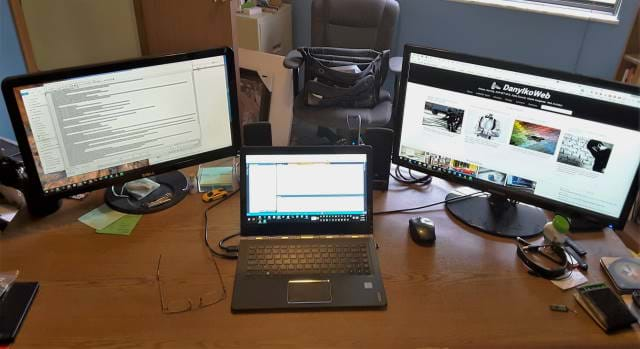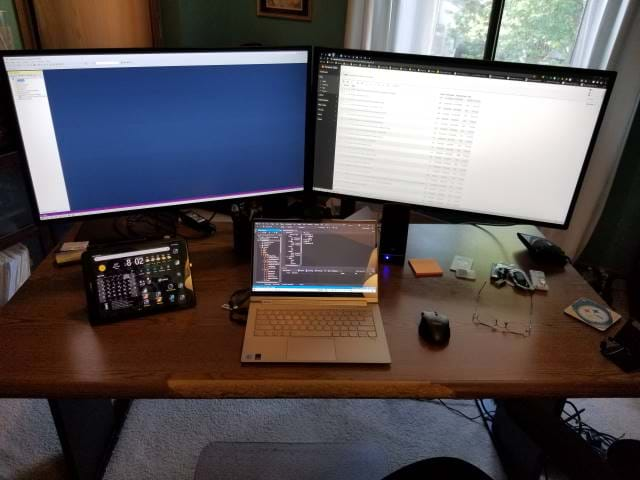Remote Work: Upgrading Your Workspace
For those looking to upgrade their home office, today, I review a checklist of essential tools for working remotely.

Last week, I mentioned the need to purchase some new hardware for my home office using whatever deals I could find on the Internet.
After searching through some feeds and finding a fantastic deal on a new Lenovo laptop and monitors (explained later), I was able to get back on my career feet with all of these new shiny tools. Over the last month, I also had some developers ask about how to upgrade their remote workspace.
Since this was essentially what I went through in the last two weeks, I'll cover how I upgraded my home office out of necessity.
While I'm a developer, I'll try to keep this as neutral as possible so it works with anyone who works remotely.
Think of this post as a checklist for upgrading your home office during these crazy COVIDIAN times.
Determine the Essentials
Mentioning "essentials" can trigger different connotations to individuals. A writer may see a pen and paper as an essential tool where a developer absolutely requires a laptop.
Like a carpenter, you can't perform any work unless you have the essential tools (like a hammer, duh) to perform your job at an optimum level.
Again, I want to make this list as generic as possible to benefit users who work remotely in this digital, global era.
Laptop
I've mentioned this in a past article (and as a teenager) saying,
It doesn't matter if your job is a ballerina, you need to know how to use a computer.
While this has held true over the years, it re-affirmed my beliefs given this technology-driven culture.
So let's address the elephant in the room, shall we?
One of the essential components for your job is a solid laptop. I'm not saying go out and buy the best laptop available, but base your laptop decision on the requirements of your job (or better yet, your career).
For example, as a developer, I know I require a somewhat beefy machine for compiling, writing code, and other tasks during the day (mumblemumbleDiablomumble).
However, one of my relatives uses their laptop for simply checking email and writing articles. As you can imagine, this doesn't require any significant number-crunching processes with Excel or Autocad, but requires somewhat of a responsive laptop, right?
What I'm saying is match your laptop purchase to your career needs/requirements.
Monitors
When I was younger, one of the turning points in my career was using two monitors (I know, I live a sheltered life).
Once the hardware could support more "desktop" space, it made my development so much easier. Based on survey results, most developers require the use of another monitor.
For a general dev setup, one monitor is your primary development (usually the laptop) and the second monitor is your debugging/browsing monitor. Optionally, a third monitor could be for email, notifications (Twitter feeds, etc), or miscellaneous utilities running in the background.
While developers require at least one extra monitor, it may be overkill for someone else. Going back to a writer's perspective, it makes sense to have one monitor so you can focus on your writing with no distractions.
If you have only one monitor, I would encourage you to upgrade to an additional monitor (or two).
Multiple monitors are great for productivity.
Desk
While a kitchen table as a desk doesn't appeal to me, I feel a spacious desk is also one essential for a remote workspace.
So yes, I still feel the need to push the laptop aside, grab a pen and paper, and draw, write, create preliminary diagrams, and other analog functions.
I see everyone with their nice, clean workspaces and I look at mine and go "who threw a grenade in here?" Hey, some people like messy desks.
I've had my desk for a loooong time and it's getting a little long in the tooth. I'm thinking about a sitting/standing desk, but I'm trying to restrain myself and recuperate from my purchases so far this year.
Also, if anyone purchased a good standing/sitting desk and would like to recommend one, please post in the comments below.
Chair
As Hanselman mentioned, "Brain, Bytes, Back, Buns" are the most important parts for developers.
Over the years, I've been wrestling with finding the best chair for my needs. I've even received a chair from a relative where it wasn't comfortable or functional and we had to take it back.
I feel this is a touchy issue. It's like buying clothes on the Internet. You order them, then try them on. This is the reason I visit Staples, Office Max, or any other brick-and-mortar store. I can actually sit down and test the chairs.
A month after quarantine, my chair broke and I couldn't adjust the height. The chair was always in the lowest position. I felt like I was on the floor with my hands above my head typing on the keyboard.
At the time of quarantine, everyone was purchasing chairs to prepare for remote work so every good chair I found online was sold out. So I took a chance on Amazon and bought a Flash Furniture High Back Office Chair (affiliate link).
Again, define your requirements: Need a headrest, adjustable arms, and adjustable height. Everything seemed to fit, so I ordered it.
Overall, I'm thrilled with this purchase.
Headphones/Earbuds
For your home/remote office to be truly productive, sometimes you need focus and concentration on finishing certain tasks with no distractions.
Enter headphones or earbuds.
While closing the door completely is a great way to avoid interruptions, there's always putting on headphones.
I personally have a problem paying over $150 for headphones where wireless earbuds work just fine.
Accessories
Dual Arm Monitor Mount
Dual monitors can take up a large amount of space on your desk with their large, flat base. Again, I need my space.
So one of my quick purchases I made from Amazon was Dual Arm Monitor Mounts from ElTab (affiliate link). This monitor mount uses a huge clamp to hold everything in place.
This purchase gave me more space than I thought possible with the monitors 6-inches above the desk.
For $20, I couldn't beat the deal and I have to admit: this cleaned up my desk and I didn't even expect it.
Logitech WebCam C920
How can you have any meetings without seeing your gorgeous face?
When I had my Dell XPS 9560, it had the webcam at the bottom of the screen (I call it the nose-cam and BTW, Dell? I did not like it).
I decided to take matters into my own hands and purchased the Logitech C920 Webcam (affiliate link). At 1080p, I felt it was a good purchase at the time and decided to keep it and transition it over to my Lenovo.
The Logitech C920 Webcam works great with Skype, Microsoft Teams, WebMeeting, and Zoom since I've used all in the last 4 months.
Upgrading My Workspace
If you've read the review of my Lenovo Yoga C940, you know I needed a new laptop. My old laptop was missing keys, kept BSOD'ing on me (Blue Screen of Death). It was time.
Then my monitors died on me. BOTH of them. At the same time.
I started looking through all of my deal feeds.
Two weeks ago, I found a steal on a monitor: an Acer 32-inch monitor for $200 (copy of deal).
So I bought two.
This was my setup before (this is also the image on the home page).

This is my setup now.

The old setup didn't provide enough workspace where the new setup got the monitors out of the way and allowed me to clean the desk once in a while.
As a recap of my home office upgrade, I had to buy a new laptop, docking station, new monitors, and a monitor mount.
Conclusion
When upgrading your home office, it doesn't have to be something stuffy. Still professional, but not stuffy.
Because in the end, it is your home. Decorate it the way you want. Make it feel like an office, but ultimately decorate it to make you feel comfortable while you work.
It also helps to upgrade your old equipment like your monitors...
...however, these new monitors make me feel like I'm in a double-feature drive-in.
Have you purchased any home office hardware during quarantine? Tell me, tell me, tell me...Post your comments below and let's discuss your new toys!





